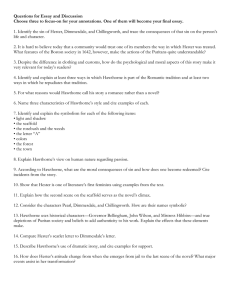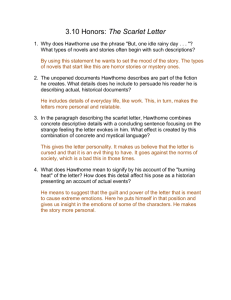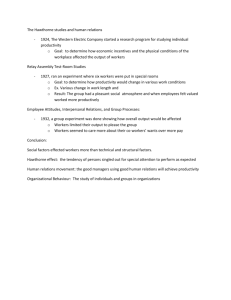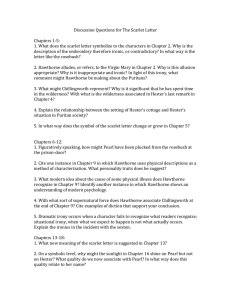21L.702 Studies in Fiction: Rethinking the American Masterpiece MIT OpenCourseWare Fall 2007
advertisement
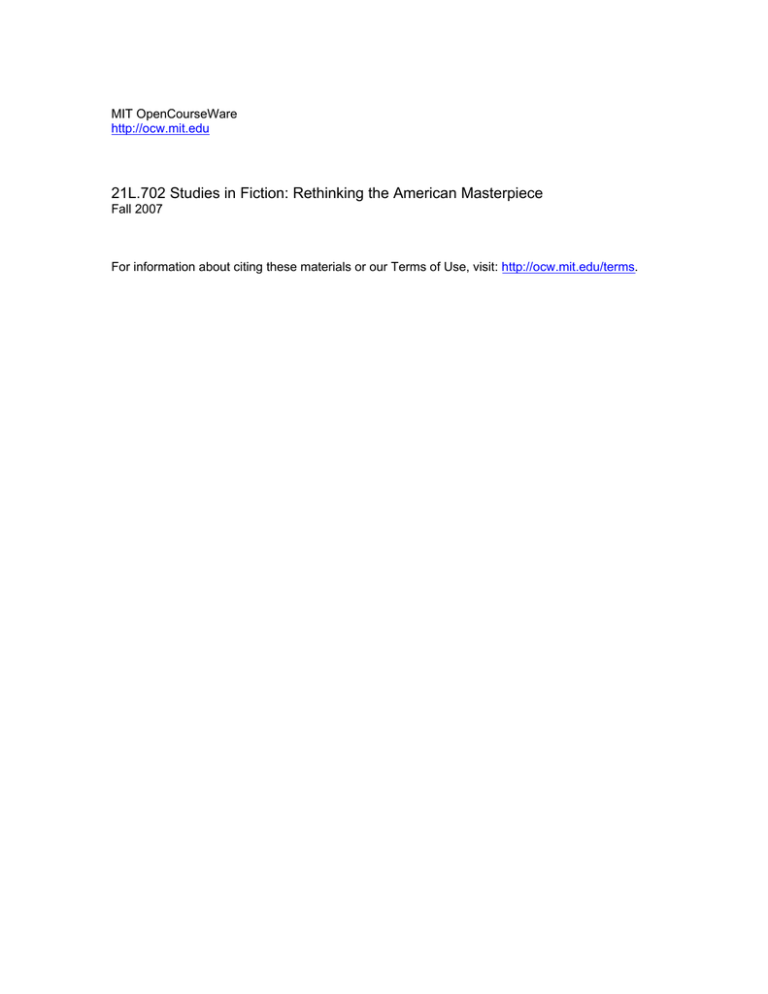
MIT OpenCourseWare http://ocw.mit.edu 21L.702 Studies in Fiction: Rethinking the American Masterpiece Fall 2007 For information about citing these materials or our Terms of Use, visit: http://ocw.mit.edu/terms. Alice Chiang 10/9/2007 21L.702 – MW 2:30-5pm Essay 1 Hawthorne’s redefinition of the market-place It is commonly known that Nathaniel Hawthorne, author of The Scarlet Letter, faced financial difficulties during the earlier years of his writing career. Not only did Hawthorne take a job at a Custom-House, but his troubles affected his ability to care for his family. The series introduction, “Introduction: Biographical and Historical Contexts” clearly illustrates the state of Hawthorne’s financial affairs: “But pleasant and productive as the times were, the certainly were not prosperous; the family became so poor, in fact, that at one point in 1844 Sophia and Una had to go live with the Peabodys while Hawthorne returned, briefly, to live with his mother – just to enable him to pay the bills.” (7) Perhaps Hawthorne’s own circumstances led him to write a novel which discusses the dynamic between financial stability and self-preservation. At the time of Hawthorne’s writing, which is often referred to as “Jacksonian America,” writers had already explored the ideas of “cult of domesticity” and the divisions between public and private spheres. The public sphere, associated with one’s career and activities outside of the home was separate from the private sphere, associated with one’s family life and relationships within the confines of the household. It is possible that Hawthorne, although aware of this shift in society’s public and private spheres, was unable to adjust to an emerging trend. Like some of his characters, Hawthorne needed to reconcile his worth in an economic setting. Hawthorne’s interests lie in the concepts of the market-place, the change of the marketplace’s role, and its effect on the public and private spheres. Undoubtedly, Hawthorne’s marketplace is a key motif, which displaces the function of the traditional market-place. Instead, this “new” market-place using the same terms that define a market-place and applies them to a private setting, obscuring the line between public and private life. Several of the pivotal scenes in The Scarlet Letter center around the market-place. Traditionally, market-places acted as economic centers that valued and exchanged products made by laborers; it was a location where goods were bought, sold, or traded and debts owed and repaid. Hawthorne’s “new” market-place serves its primary purpose, while simultaneously introducing the concept of intrinsic value. This new market-place blurs the divisions between public and private spheres. It is no longer just a place where one’s skills are valued, but a site where people are judged. Hawthorne takes the traditional activities of the market-place and infiltrates the private sphere with business imagery. Hawthorne focuses on his character’s possessions, the skills they offer, their debts, and the market-place’s role in conveying this information. Hawthorne deliberately chooses to follow the first Custom House chapter with a chapter titled “The Market-place.” The opening scene contains several references to commerce and “business” (55). The crowd that has gathered looks upon Hester and Dimmesdale commands Hester to “show [her] scarlet letter in the market-place (58)!” Several of the characters are defined by their worth in the market-place, or the skill that they provide and the value that these skills bring to the community. The reader first meets all of the major characters in an auctiontype scene that takes place in the market-place. Early in the story, the reader learns that Hester, whose knitting connects her to commerce, “hath good skill at her needle, that’s certain (58).” In fact, she is able to continue living in the community because her trade creates value: “She possessed an art that sufficed, even in a land that afforded comparatively little scope for its exercise, to supply food for her thriving infant and herself. It was the art – then, as now, almost the only one within a woman’s grasp – of needle-work (76).” Ironically, Hester’s knitting, which connects her to the marketplace and the rest of the community, is an individual and solitary activity done in the privacy of her own home. Perhaps Hawthorne intended to emphasize her status as a separate and isolated member of society. Roger Chillingworth’s communal contribution is his physical healing powers, which are initially welcome by the community because “skilful men, of the medical and chirurgical profession, were of rare occurrence in the colony (102).” However, the reader and community begin to question his worth, as Hawthorne reveals he practices a form of alchemy, an example of a violation of God’s natural order. Chillingworth takes advantage of his status as a physician and transgresses on Dimmesdale’s private sphere. In several intimate scenes, Hawthorne suggests that Chillingworth’s violations are a result of inaccurate market appraisal: …if, to these qualifications of a confidant be joined the advantages afforded by his recognized character as a physician; -- then, at some inevitable moment, will the soul of the sufferer be dissolved, and flow forth in a dark, but transparent stream, bringing all its mysteries into the daylight. (106) While Arthur Dimmesdale’s trade does not generate cash flow, he adds a different kind of value to the community. In contrast to Chillingworth’s physical healing power, Dimmesdale’s skill lies in the emotional and spiritual relief he offers. Interestingly, Hawthorne prevents Dimmesdale from achieving such happiness and pleasure, perhaps because his skill does not provide economic compensation. One might question the relevance of these characters’ occupations. However, employment typically results in money and financial payment usually leads to the acquisition of property. Interestingly, Hawthorne’s portrays Pearl as Hester’s possession, since Hester’s sin determines and maintains ownership of Pearl’s future. It is hardly fortuitous that the reader’s first meeting with Hester and Pearl is in the market-place and that Pearl is depicted as an object that Hester owns. In the introductory scene, Hester instinctively holds Pearl to her bosom, further claiming ownership of her child. Additionally, Hawthorne often alludes to Pearl as a token, which can be interpreted as a unit of monetary exchange, or simply an item of great value: “Her Pearl! – For so had Hester called her; not as a name expressive of her aspect, which had nothing of the calm, white, unimpassioned lustre that would be indicated by comparison. But she named the infant “Pearl,” as being of great price, -- purchased with all she had, -- her mother’s only treasure (81).” Hawthorne’s unflattering depiction of the Puritans suggests he believes that the Puritans owe Hester some form of an apology. This concept of debt and repayment is repeated throughout the story. When Hester steps out into the market-place at the beginning of the book, Hawthorne suggests that the observers’ behavior deserves Hester’s anger: “Had a roar of laughter burst form the multitude, – each man, each woman, each little shrill-voiced child, contributing their individual parts – Hester Prynne might have repaid them all with a bitter and disdainful smile (60).” Apart from the payment that Hester deserves, other characters owe debts incurred in the marketplace. After Hester realizes Chillingworth’s intentions, she uses monetary terms to describe the obligations: “Hast thou not nurtured him enough?” said Hester, noticing the old man’s look. “Has he not paid thee all?” “No! – no! – He has but increased the debt!” answered the physician. (139) Again, Hawthorne has brought the market-place into their private sphere. Debts that are usually repaid in monetary form now seem to involve revelations of truth. Even Hester realizes this and considers paying Dimmesdale a “long debt of confidence” by revealing Chillingworth’s true character and motives (140). Finally, the market-place is a place where people and objects are closely inspected. The observers are searching for an exterior way to determine one’s value to the community and individual worth. Hester’s needlework quickly establishes her as a worthy contributor to the influential residents of the community. This recognition brings her, both physically and figuratively, into the homes of the town’s wealthiest and most powerful: Public ceremonies, such as ordinations, the installation of magistrates, and all that could give majesty to the forms in which a new government manifested itself to the people, were, as a matter of policy, marked by a stately and well-conducted ceremonial, and a somber, but yet a studied magnificence. Deep ruffs, painfully wrought bands, and gorgeously embroidered gloves, were all deemed necessary to the official state of men assuming the reins of wealth, even while sumptuary laws forbade these and similar extravagances to the plebeian order. (77) Hawthorne states that a paradox exists within this Puritan community. While it claims that God is supreme and the most important force in their lives, commerce plays an overwhelming role in their daily lives that rivals His power. Hawthorne certainly connects his The Scarlet Letter characters to one other within social spheres, but also links them through activity in the market-place. These complex associations suggest that he and his peers struggled with the intertwining of the public and private spheres that stemmed from the evolution of market-place. Furthermore, Hawthorne implies that work and issues associated with financial security could no longer be compartmentalized into one’s public sphere. Even in a Puritan society, where the citizens disavow the importance of money and luxury, capitalism and money penetrate deeply into the private sphere. Works Cited Primary Sources Hawthorne, Nathaniel. The Scarlet Letter. Edited by S. S. Williams. New York, NY: Bedford/St. Martin's, 2006.

